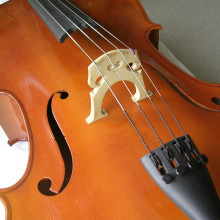Music Science: From Mozart to Marketing
Mozart or Motown, most of us love music. We’re digging into the science behind this much-loved pass time, be it listening to your favourite tunes, or playing them for yourself. Plus in the news - the discovery of an orphan planet, succumbing to robo peer pressure and do lemmings really jump off cliffs? We'll be finding out.
Music: Josh Kirsch, Media Right Productions
In this episode

00:49 - Liquid-based battery
Liquid-based battery
with Professor Lee Cronin, University of Glasgow
We’ve all been there - you need your phone for an emergency call or a look a map and... the battery's dead. Getting better batteries could change not only our smartphone use, but it is one of the biggest challenges for getting people to take up electric vehicles. And while batteries have improved in leaps and bounds since the 80s, there’s still a very long way to go and progress has stalled in recent years. But the good news is that Glasgow chemist Lee Cronin has come up with a totally new battery concept: a super-charged liquid that you pump like petrol. Chris Smith asked him what's holding back present battery technology, and how his new system works...
Lee - Electricity is electrons flowing and the way we make batteries, or store power in batteries is we cram as many electrons as we can into the can if you like. When we squeeze them in they jostle up against one another and they heat up the battery material. And the battery literally starts to get a bit too hot and if it’s too hot then it can start to degrade.
Chris - How are you trying to surmount this?
Lee - We are pretty good at making nanoclusters, and these are basically taking lumps of metal at the nanoscale that we can add lots of electrons to in a very small space. And because we’re able to add them into this condensed space, they are able to go in without too much heat. And the beautiful thing is we can get lots of them in there and because the molecule is a nano type molecule, it’s a cage, it stays pretty good and doesn’t fall apart.
Chris - So this is a completely new battery material that you’re coming up with?
Lee - Yes. And also this material we have made a flow battery so the battery material’s are actually liquid. We actually pour the electrons into the nanocluster which is actually in water.
Chris - What is the chemical that’s enabling you to do this?
Lee - This is a derivative of tungsten oxide. It’s actually like a rich rust. A very expensive rust compared to say iron oxide but it’s the same principle. The oxide is able to store the electrons on the metal within the cluster. So if we were able to make a cluster out of say 18 metals, which we have here, we can get a whopping 18 electrons into a really small nano volume.
Chris - Okay. So paint a picture for me then because everyone’s familiar with what a Duracell battery, or an Eveready battery looks like: you know one of these cells that we buy and we put into a TV remote control. How would this differ from that?
Lee - In the Duracell, the battery has a solid electrolyte where the chemicals are mixed are a solid. But in our system, we’re able to flow the electrolyte around between the electrodes, which we call the “anode” and the “cathode.” The point is when the battery’s normally exhausted with the Duracell you either have to charge it up or you throw it away. In our battery what you can do is charge it up, but if you need a quick charge you just drain out the liquid and fill up the tank again. It’s just like a gasolene tank.
So we’re imagining the we could actually put this into an electric vehicle, and when the electric vehicle was flat you’d go to the petrol station. But rather than filling up with diesel or petrol, you’d remove the spent electrolyte and then pour in the fully charged new electrolyte. That would take a few seconds and then you could zoom away again in your electric car for many hundreds of miles.
Chris - But, critically, you could regenerate the electrolyte that’s exhausted?
Lee - Exactly. Because the material doesn’t degrade you just recycle it again. Probably take it away in a tanker to a power station, recharge it, and bring it back. And the beautiful thing is it uses all the liquid infrastructure we have so people would not get range anxiety about “can I find a plug, can I find some electricity?” They’re used to going to a petrol station and getting liquid and putting it in the tank.
Chris - How would your new electrolyte based system compare with the best the industry has to offer at the moment?
Lee - Actually, very well. In fact, it’s a little bit better practically than what is achieved right now and we do have a new idea using this that could make it up to five times better. But right now I’d say were about 1.5 times better but we could be many many times faster charging. Well not charging, but removing the electrolyte and putting in new stuff.
Chris - Is it safe?
Lee - Well, it’s corrosive. It’s like a lead acid battery; it’s pretty corrosive and you need to be careful that you don’t burn yourself and the materials you use are up to the job. But compared to a lead acid battery I guess it is pretty safe.

05:59 - Stopping senescence to regrow livers
Stopping senescence to regrow livers
with Dr Thomas Bird, Royal Infirmary of Edinburgh, Cancer Research UK Beaston Institute
Every year, thousands of people develop acute liver failure caused by viral infections, like hepatitis, or poisoning by drugs like paracetamol. In many cases the only way to save these individuals is with a liver transplant, but a shortage of donor organs, and the fact that often these cases often occur in resource-poor settings, means that many victims die before they can receive a new liver. But now researchers in Edinburgh have made a surprising discovery that might improve the odds considerably: they've found that many poisoned livers actually have the potential to rebuild themselves from stem cells, but they're prevented from doing so by the presence of injured cells that have switched into a state called "senescence" and begun churning out signals that make other healthy cells become senescent too, and stop growing. By blocking these signals, the ability of livers to self-repair can be dramatically improved as Katie Haylor heard from the study's lead author, Thomas Bird...
Thomas - What we were really interested in is if you have someone with acute liver failure who had a normal liver just a few days earlier, in the very sickest patients who needed liver transplants to save their lives the raw materials for regeneration are quite often there in reasonable numbers within the liver. But what was striking is they don’t seem to be proliferating, they seem to have stopped their ability to regenerate. And so we in the study were really trying to drill down and answer the question of why those cells failed to regenerate in the most severe forms of liver injury.
Katie - What did you actually do?
Thomas - First of all we examined those livers taken out of liver transplant patients, but then we got a whole series of patients who had much milder forms of injury and we graded how severe the liver injury was compared to what the biopsy taken for diagnosis of their liver disease showed. And what we were able to see was as you increased the level of injury from relatively mild to quite severe, you saw less and less proliferation of the severe end of that spectrum and we started to see the development of senescence markers. Senescence is a state of cell shock or stunning associated with permanent growth arrest which means that the regenerative cells can’t proliferate. So the idea here is you’d ideally want after large injury to have large amounts of regeneration but, unfortunately, after severe liver injury you actually stop the regenerative ability. So you’re tying it in chains in essence.
Katie - Okay. So the thinking is that this acute, severe liver injury is instigating this senescence, this zombified state of cells, and do you see this spread then throughout the liver?
Thomas - That was, I think, the most exciting features of our research which was we showed that the senescence is there at the point where injury is receding, and we were able to use genetic models to study what happens if you induce senescence in one cell to the cells in that local environment. What we were able to see was senescence could actually spread from a cell that is itself stressed to other neighbouring cells that are only responding to the cues in their environment.
So the idea here is that once senescence is established it can then spread across the liver and prevent regeneration in other areas further away from injury. The exact mechanism by which a cell that is injured induces its own senescence still needs to be clarified. And there are some exciting avenues we have in that, but we don’t know that thoroughly at the moment.
Katie - So now that you know that this senescence is spreading, what can you do about it?
Thomas - What we found was that a signaling molecule called TGF-beta is absolutely critical for that spread of senescence from injury and senescence to other uninjured cells that then become senescent. We were able to inhibit that signalling pathway and actually reduce the senescence and improve regeneration in organs. And what was key there was that we could then, in a mouse model, deliver a toxic dose of paracetamol which would otherwise be fatal, prevent the senescence, allow regeneration and those mice didn't succumb to what would otherwise be a fatal liver injury. They recovered and regenerated their livers normally. So the hope is, of course, that that would be directly translatable to humans.
Katie - Wow! So you’re kick-starting this process of regeneration. What did you use to do so?
Thomas - We started with genetic models where we could actually remove the receptor for TGF-beta specifically in the hepatocyte that would become senescent. But then we went on to use both commercially available chemicals compounds, but also with a collaboration with AstraZeneca using one of their more potent inhibitors which we then used in our preclinical studies. And that was the drug we saw the biggest clinical affect with and the survival in otherwise fatal injury models in mice.
This class of compounds inhibiting that receptor are commercially available and are in clinical trials. They’ve been through phase 1 and phase 2 in human studies in cancer, and what we’re hoping is that allows us quite quickly then to go onto clinical trials in acute liver failure to see how effective these drugs really are.
Katie - We’ve known for a while haven’t we that cell senescence can cause issues in the body, so where does the novelty with this study come in?
Thomas - Not only have we been able to show that acute damage to an organ produces senescence, and what that means is that any injury in any other organ may potentially have the same response. But the other critical thing is that the senescence actually spreads from cell to cell and we’ve been able to show that in a living animals for the first time. And so what we know have is a mechanism that allows that senescence to spread themselves from cell to cell, but we can then attack therapeutically and develop clinical compounds.

12:19 - Orphan planet discovered
Orphan planet discovered
with Professor David Rothery, The Open University
This will surprise you - space is huge! This means that scientists are constantly finding new, strange things that confound what we know. Using radio astronomy, scientists have discovered what looks like an enormous planet all on its own in deep space. Adam Murphy found out more from The Open University's David Rothery...
Adam - Our planet, the seven others, all the planetoids, and countless other rocks are held together by our bright shining star - our Sun. But not every prospective star gets to shine and not every planet gets a sun. Scientists in California, Colorado, and Arizona have found one of these orphan planets 20 light years away.
It’s as large as 12 Jupiters, the largest planet in our solar system. It’s so large that it just falls short of becoming a star. But how could something like this come to be? To learn more about it I spoke with David Rothery, Professor of GeoPlanetary Sciences at the Open University…
David - How do you get a planet floating around on it’s own. Well, there are two ways: one way is you just form the planet in the same way that you’d form a star. A cloud of gas and dust and the interstellar medium starts to contract under its own gravity. And if it’s a big enough cloud you’ll get a star and maybe some planets around the star. If it’s a small cloud, all you can get is a brown dwarf, or even a smaller cloud and all you’ll get is a rogue isolated planet formed on its own.
Another way would be it could have begun as a planet round a normal star and been flung out from that star somehow. Orbits are very chaotic in the early stages of growth of a stellar planetary system because there’s still gas and dust affecting the object’s motions so you can get objects thrown out. So maybe this object began around a normal star and then was thrown out of that stellar system to wander space on its own.
Adam - But why is it a failed star stuck in darkness? What would be different if it had just that little bit more mass to it?
David - It’s glowing too faintly to be a proper star. In fact, it’s not even what we’d call a brown dwarf. The mass estimates come out at about 12 times the mass of Jupiter which is right on the boundary of the mass that you need for a body’s own gravity to compress its interior to sufficient pressures that deuterium, that’s the heavy isotope of hydrogen, can start undergoing nuclear fusion. Bodies from 12 to about 80 Jupiter masses are called brown dwarfs, their fusing deuterium which is much less common than proper hydrogen. And they’re never going to become normal stars like the Sun because you need to be fuzing hydrogen to undergo the processes which really we think of as going on in a star.
Adam - This orphan ball of gas has a few interesting things about it though. It has an aurora like our Northern Lights which has proven to be something of a mystery.
David - Well on Earth, the aurora are caused when charge particles streaming out from the Sun, mostly protons are channeled along Earth’s magnetic field lines and hit the Earth’s atmosphere above the Poles, and that ionises atmospheric gases high in the atmosphere and you get the glow.
Now what I’ve not been able to figure out is what they think is triggering the aurora in these objects because none of them is orbiting another star or a larger object, but something is impinging on their atmospheres and causing the auroral emissions.
Adam - So is this rogue orphan planet a quirk of a near infinite universe or are they something that could be hiding everywhere?
David - There haven’t been many detections of orphan planets wandering round space on their own, but you can estimate that given we’ve detected some there could easily be as many orphan planets blundering around the galaxy as there are stars in the galaxy. These could be very very abundant objects.

16:38 - Myth: The truth about lemmings
Myth: The truth about lemmings
with Georgia Mills
For this week's mythconception, Georgia Mills has been uncovering the dark past of a commonly-held belief about lemmings...
Georgia - Lemmings are, by all appearances unremarkable little rodents, but with a remarkable reputation for throwing themselves off cliffs. The legend goes that huge swarms of the hamster-like creatures commit mass suicide, either through said cliff jumping or from careering straight into the sea.
And it is true that Norwegian lemmings would suddenly appear in huge numbers every few years before suddenly they’d apparently be wiped out to near extinction before the cycle would repeat.
Back in the 1500s this lead to someone to speculate that lemmings popped into existence in storm clouds before falling to the ground. A contemporary challenged this nonsense. Of course they didn’t appear in mid-air, they blew in on the wind.
And one folk tale even had people believe that when individual lemmings got too angry they simply exploded.
And the theory that still sticks to this day was that for the greater good of the species when the population grew too big the altruistic lemmings would run, in hoards, off of cliffs and drown themselves.
It sounds unbelievable. And it should do as, evolutionary speaking, it makes absolutely no sense. A selfless and suicidal lemming would be taken out of gene pool, while a selfish lemming who didn’t follow the crowd would have lots of babies and reproduce successfully. The cliff jumping behaviour would die out.
But there’s a reason this paradoxical plunging is still so widely believed - it was actually caught on camera. In 1950 Disney filmed a documentary called White Wilderness, and they got some never before seen footage of some lemmings hurling themselves off a cliff to their doom. So… case closed?
Well, here’s the rub and this may be distressing to some listeners. It certainly distressed me that these lemmings didn’t jump - they were pushed. The producers having fallen for the legend themselves wanted to include it in their documentary, but after they couldn’t see it for real they imported a whole bunch of lemmings and threw them off the cliff themselves.
Apart from contributing to the untimely and unnecessary deaths of some of Mickey Mouse’s close cousins this Academy Award winning documentary cemented the lemming myth in people’s minds for many years. But the deception has been exposed and safely assuming they aren’t spontaneously appearing in clouds or exploding we still need to explain this sudden appearance and disappearance of these lemmings.
Even now, we don’t have the whole story but we have many parts of the puzzle. Norwegian lemmings are fast breeders; if the environment is forgiving the numbers will increase dramatically. And when it’s cold lemmings can survive underneath the snow where they can breed safely before suddenly appearing in spring as if from nowhere. And when there are too many lemmings their numbers will start to drop; they run out of food; they’re picked off by predators, and many of the infants are killed by males.
Plus, when it’s too crowded herds of lemmings will migrate to pastures new. This mass migration can involve travelling down steep hills or swimming across small bodies of water, and sometimes lemmings might fall or drown. But the ones that survive get back to their breeding in a brave new world.
So to summarise, a very dynamic population size has led to the many myths about lemmings. And while the odd calamities lemming might blunder off a cliff, or be thrown by TV producers, there’s zero evidence they’ve ever tried to kill themselves.

20:01 - Would you succumb to robo peer pressure?
Would you succumb to robo peer pressure?
with Professor Tony Belpaeme, University of Plymouth and Ghent University
Would you let a robot influence your judgement in the same way you might take advice from your friends and family? It’s, surprisingly, an important consideration because robotic devices, including things like virtual assistants, are spreading rapidly in society, so we need to know how they can influence people, and especially children. Katie Haylor heard how the University of Plymouth’s Tony Belpaeme is going about it...
Tony - We’ve been using robots, and specifically social robots, so these are not robots that make you a cup of tea or that would hoover the house, but these are robots that would interact with you on a social level. And we’ve been using these robots in hospitals, in schools, and quite often these robots need to be very convincing there. They need to convince you to stick to a dietary programme or they need to convince you to do your homework. And we were having a chat with some psychologists about how can we measure really how convincing our robots are, and that’s how we arrived at measuring how much peer pressure a robot can exert on people.
Katie - Peer pressure is quite a common concept in terms of human to human peer pressure, right?
Tony - It is, it is. We all know that we follow the herd; we wear what the others are wearing; we say what the others are saying. In the 1950s Solomon Asch devised a very simple and elegant experiment to actually measure how much we succumb to peer pressure. So you’ve got a group of people, they're brought into a room, and all of them except one are accomplices - they’re into the game.
You let these people do a simple visual task. On the screen you show four lines and they need to say which two lines match in length. And it’s such an easy task that if you would be alone in the room you would be near perfect. But what if all people in the room actually give wrong answers? They consistently say the wrong line, the one that doesn’t match. Will you follow suit; will you succumb to peer pressure or will you stick to the correct answer? That’s the twist in the experiment. Usually it’s been done with people to see how much we follow social pressure from a group of people, and this time we replaced the people by robots.
Katie - Okay. So tell me what you did in this study.
Tony - Because this experiment was done in the 1950s we first wanted to check if now in the 21st century people still succumbed to peer pressure in this experiment. So we did the experiment all over again and much to our surprise really, people still kind of followed suit. They follow what the others are saying even if that answer is wrong. So we knew that the setup works, the experiment works and then we kind of removed the adults and replaced them by robots. It’s a small group of robots; only three robots and we checked if the adults would succumb to peer pressure by the robots, which they didn’t.
But then we replaced the adult with a child, so now we had a child with three robots in the room doing that very simple visual test, and what we noticed was that the children followed. They succumbed to peer pressure by the robots so the robots really exert social pressure on the children to give a wrong answer.
Katie - What would you say is the significance of this finding?
Tony - On the one hand, children succumbing to peer pressure sounds sinister but it doesn’t have to be. It’s very important to us that children actually listen to what robots say and follow what robots suggest. We can make excellent use of that in education, in health care, in therapeutic support, and we’ve been doing that for many years.
But there could be a dark side to this as well. It could, for example, be that if you have one of these robots in the home and these robots suggest children to buy things, or to ask for things that they shouldn't be asking for then we know that these robots are much more convincing than any other form of technology.
We’ve had different types of technology in the home. These social robots are going to be a new form of channel through which information reaches us and it reaches us in a social manner. We now know that these robots will be able to persuade you to do things that could be good or that could be bad.

24:44 - Making music: volume and pitch
Making music: volume and pitch
with Dave Ansell, Sciansell
How do musical instruments actually work? Katie Haylor found out from science demo expert Dave Ansell...
Dave - Well, they’re producing sound. And if you’ve ever felt your throat while you’re talking you should feel a vibration, and so sound is basically just a vibration in the air. That vibration on a string instrument is happening in the strings and each string has a different pitch at which it likes to vibrate which it resonates at. So if you pluck your different strings they all vibrate at a different pitch. If you change the length of the string it will change that pitch as well, and the tautness of the strings, so when you're turning it you change the tautness of the string. But, as you heard with my beautiful acoustic electric guitar earlier.
So this is basically just the strings vibrating. It’s very quiet and it sounds pretty rubbish. But the difference between this and your cello is that your cello’s got the beautiful wooden box underneath.
Katie - Ah, this hollow box right?
Dave - Exactly. Which is there to convert the vibration in the string, which is actually quite quiet because it can’t get out into the air very efficiently, into a vibration of the air. So it’s about making the air vibrate when the string is vibrating.
Katie - Ah, so this is the natural amplifier, right, that the electric guitar achieves by being plugged into an amp?
Dave - Yes. The electric guitar gets away from having to have these big boxes by electromagnetically detecting the movements of the strings and then putting that directly into an amplifier and into a speaker.
Katie - Okay. So there are pretty important concepts that we need to get our heads around when it comes to playing musical instruments. They include pitch, and volume, and I believe you have a pretty nifty demo in order to illustrate these?
Dave - I have a very nifty demo anyway and it make lots of noise, and I think it’s quite cool.
Dave - To start of we need some producing a vibration so what I’ve got here is a hexagonal nut made out of steel. I’m just going to roll it down something here. You might be able to hear a slight noise. That was just rolling down a magazine in fact, and so that wasn’t very loud but you can hear a bit of a vibration.
If however, you take a balloon.
Katie - Oh, thank you very much.
Dave - And another nut. You put the nut in the balloon.
Katie - It’s quite hard to do. It’s quite fiddly.
Dave - Then you’re going to inflate it, yeah.
Katie - Right, okay. Here goes… Why didn’t I learn the clarinet? I’m not sure my lungs are up to this! Okay.
Georgia - Katie has gone the same colour as the balloon.
Katie - Thanks Georgia!
Dave - Which is red rather than green.
Katie - So I’ll tie it now.
Dave - Tie it off. And now instead of rolling the nut down the magazine (which obviously finishes) you have a circular thing you can roll it round. So if you swirl the balloon -
Katie - Okay. Shall I try this?
Dave - Yeah.
Katie - Okay. Here goes…
Dave - So it can start off attempting to roll but it’s just sliding. That’s what you heard then and then it suddenly started rolling and suddenly you heard lots and lots of noise.
If you compare it to my 5p coin… which is much higher but quieter. It’s quieter because the bumps on the 5p are much smaller so you’re getting smaller vibrations, and small vibrations are quiet - make a quieter noise.
Katie - Ah. So if you were to draw the vibrations over time, the amplitude of the bumps would be smaller, right?
Dave - Yeah.
Katie - In the 5p?
Dave - Yeah.
Katie - Because the ridges are smaller?
Dave - Yeah. There’s less changes in pressure so they push on your ear less hard and that’s what you hear is a quieter noise. Which is the reason when you're further away things are quieter because that sound, that energy, is spread out over more area so it can’t push on your ear as hard so it’s quieter.
Georgia - As I’m recording this I’m looking at the waveform going along and it matched what you’re saying for the 5p they were smaller and closer together. So is that pretty much the pattern of the 5p hitting the balloon?
Dave - Yep. Because the 5p hits it more often but more gently.
Katie - So the volume we covered. Higher pitch: this is the frequency of bumps, right?
Dave - So how fast the vibration is is the pitch. So because the 5p has got more smaller bumps so to roll the same distance, it’s going to bump a lot more often so it’s going to be a higher pitch noise than the nut. Big nuts make a slightly lower pitch than small nuts as well.
Katie - So there you go, we’ve got a demo you can do at home. You just need a balloon, a 5p, and a nut. And there you’ve got frequency or pitch and amplitude or volume.
Dave - And a way of annoying your parents if you’re a child!

31:12 - How are music and personality linked?
How are music and personality linked?
with Dr David Greenberg, Cambridge University and City University of New York
Could your personality influence the kind of music you listen to? Music psychologist David Greenberg has been gathering data from people all over the world to learn more about the relationship between music and personality, and Georgia Mills spoke to him to find out more...
David - What we found is that excitement seeking extroverts tend to like high arousal music so that means high energy music songs like Welcome to the Jungle or Thunderstruck by AC/DC.
On the other hand we found that individuals who who were high in openness to experience like more complex music, avant garde classical music to jazz, to opera, to world music. And they are preferring these qualities in music that are much more thoughtful and sophisticated. What’s interesting is if you look at it: let’s just take the example of openness to experience and jazz music. People with openness to experiences they are kind of seeking new things, and if they go on vacation they’re typically going to want to pick a new vacation spot each year. And with jazz music it’s so unpredictable that the very basic concept is improvisation and so there’s constantly something new moment to moment. And some music like that can be really appealing for someone who’s open to new experiences and seeking these new ideas and new aesthetics out.
Some people have a range of musical preferences and so if you look at their playlists there’s a range of music from rock, to jazz, to hip hop, to alternative, and it’s a bunch and they may switch day by day in what type of music they’re listening too. In another study we had found that people again who are high in openness to experience their record collections and their preferences are much more diverse than those who are lower in openness to experience.
There is another study that we had published which was looking at different cognitive styles. So we were looking at people who were high on empathy compared to systemisers who tend to analyse systems. What we found was that empathisers were preferring music that was more mellow, that had lower energy, also had negative emotions, and music that also had emotional depth. Wherease people high in systemising were preferring music that had high energy, positive emotions, and that also had intellectual depth.
So an empathiser might really like Nora Jones’ “Come Away with Me”, or Jeff Buckley’s version of “Hallelujah”. Systemisers were preferring more heavy metal and punk music, but at the same time what was interesting was we found that there were systemisers that were preferring music from the avant garde classical genres. And so there’s something about the complexity and almost the puzzle-like nature of that type of music and it needed to be deconstructed that was appealing to systemisers.
Georgia - Do many people listen to music and say ah yes, that’s a clever note change or - I don’t not much about music - or is it sort of happening unconsciously?
David - It depends upon the individual and that has to do with the type of musical engagement that people engage in. So there are individuals who look at music more intellectually and they are picking out the specific notes, thinking about the exact qualities especially if they’re a musician and have musical training they could say this is a F minor 7 chord going to a B flat 7 chord. Whereas others they’re just listening and they’re focused more on the energy of the music or maybe they’re focusing more on how it’s making their body move. And this also depends upon the personality of the individual and it will inform how they’re actually engaging and stepping into their musical process.
Georgia - Is there any evidence that listening to different types of music could actually influence what you’re like as a person?
David - That’s a great question. And it’s a very difficult one to answer so scientifically. Right now we’re doing studies that are looking at that question. And we’re trying to see if we were to play a piece of music - let’s say Adele’s “Hello”, and then play somebody else maybe Rage Against the Machine, how will that actually affect the listener and will it prime certain personality traits. If we were to play Joni Mitchell's “Blue”, would that make somebody more empathic than before when they listened to the song. And then another question is how long will that change last.
Georgia - If your personality says what kind of music you’re likely to listen to, how about musicians, does their personality influence the kind of music they make?
David - The way that I started my interest in this was that my saxophone teacher, as I was growing up, I noticed he had different playing styles and different personalities. So one who is much more emotional he would often, as a personality, he would play more emotionally. One who is much more intellectual will play a little bit more intellectually.
If music is self-expression then scientifically we could, potentially, show the different ways in which people are expressing their personality in theirself through music. And we’re looking at not only at our jazz musicians on average; do they have a certain personality profile compared to classical musicians? But we’re also looking to exact instrumentalists. So drummers; do they have certain personalities compared to vocalist, compared to pianists, compared to say brass players?
This is going to be important on several levels, not only just how music is performing self-expression but when we think about how we first start to play an instrument, those of us who are musicians. Many times it’s a guessing game. Parents will want or encourage their children to play an instrument or the child will have an eagerness to want to start to learn. But the question is well, what type of instrument to play. If you had a 7 year old you’re not going to give them an instrument to play that is, you know, huge. You might start them off with something that’s smaller that they can hold or they may start them out on the piano.
But what the research that we’re doing now on instrumentalists and personality, what that may eventually inform is to say “Okay, well you have an 8 year old. Let’s look at their personality profile”, and we can predict which type of instrument and even what type of musical style they might not only be most successful in, but that they’ll most enjoy.
Georgia - Has your research given any clues as to what people who play the ukulele are like?
David - Not, not yet...

38:44 - Can listening to classical music make your kids smarter?
Can listening to classical music make your kids smarter?
with Dr Duncan Astle, Cambridge University
The Mozart Effect is a term given to the idea that listening to classical music can make your child more intelligent. This might be good news for music vendors, but does it stand up to scientific scrutiny? Katie Haylor put this to Cambridge University neuroscientist Duncan Astle...
Duncan - Well, the Mozart Effect, so-called, stems from an original paper in 1993 where the authors compare people’s performance - these were adults - immediately after listening to Mozart versus just silence. And they found that there was a short-lived boost to performance on particular spatial exercises following the Mozart. The original authors were quite muted - pun intended - on their findings. But of course when the findings sort of hit the more popular media, it got somewhat sensationalised, the idea that playing Mozart will make you more intelligent or make you smarter.
Then it really took off later in the 90s when a guy called Don Campbell published a book which is titled “The Mozart Effect: Tapping the Power of Music to Heal the Body, Strengthen the Mind and Unlock the Creative Spirit.” And that really spurned this idea that playing classical music, Mozart in particular, or listening to it will make you more intelligent, and that’s where the Mozart Effect, so-called, comes from.
Katie - So this was actually done with adults and not kids then?
Duncan - Yeah. It was done with kids. He later published a book which is called “The Mozart Effect for Children” and a whole industry kind of came about, even to the point that one state in the US allocated some of its budget to buy every child a CD so that they could listen to Mozart and enjoy the benefits.
Katie - Right. So how much scientific weight does this hold?
Duncan - Well, the Mozart effect’s been incredibly difficult to replicate so other labs who have tried to run a similar study have found it very hard to show the same effects. I think current opinion seems to suggest that it’s likely more to be an “arousal effect”. Other studies have shown that if you play people music that they like or they have a preference for, it can have a positive impact on their arousal, and that might have short-lived benefits for particular cognitive exercises. So rather than make people smarter per se, it might have an impact on mood or arousal.
Katie - Okay. So can we say then that playing your kids classical music does not necessarily make them more intelligent.
Duncan - There’s no compelling evidence to suggest that it would.
Katie - Got it. Rather than listening to music, what about playing music? Is there any evidence to suggest that getting your kiddies to learn an instrument could have any cognitive benefit.
Duncan - Well, it’s quite hard to study because you can’t just sort of roundup kids who play musical instruments and compare them with those who don't because there might be all sorts of other differences. It’s hard to attribute any difference just to learning to play a musical instrument.
But there have been some really nice studies where scientists have followed children over time or where they randomly allocated children to different type of musical training. And they have shown it can have some positive benefits for fine motor skills or listening skills. Some studies have used brain imaging to show that brain areas associated with those skills showed changes and that certain connective pathways in the brain so, for example, the connections between the two halves of the brain are boosted by musical training. So there is more compelling evidence that learning to play a musical instrument could have positive benefit for children’s cognition.
Katie - What about listening to music then whatever your age, whatever music you want to listen to, should we be doing it? Is there a cognitive impact?
Duncan - I think we should be doing it. I think it’s hard to demonstrate that there’s a direct cognitive benefit to doing so. But there is very good evidence that will have a positive benefit on the mood, reducing stress, that kind of thing which could improve performance. But that’s not the same as saying that’s making you smarter by listening to it.
Katie - So you have a musical instrument Duncan?
Duncan - I do. I can play the oboe.
Katie - Ah! And you didn’t bring it in for us to play.
Duncan - If only you’d asked.
Katie - Ah no! Okay, well next time.
Georgia - I have a question Duncan. So there’s some genres of music that have a tainted reputation, that people associate listening to with doing bad things or being more aggresive. ACDC, Marilyn Manson, that sort of thing. Is there any evidence that music can negatively affect your personality or make you less intelligent?
Duncan - Not negatively affect your personality or intelligence, but people have shown that it can have a relatively short-lived effect on mood. So it does stand to reason that if you listen to highly aggressive music that might have a short carry over effect, or a priming effect, on your mood and state of mind.

44:07 - Can music in shops make us buy more?
Can music in shops make us buy more?
with Professor Ian Cross, Cambridge University
It goes without saying that music is big business - whether it’s buying concert tickets or streaming music from the internet. But to what extent can music itself be good for business? What’s the science behind what shops put through their speakers, and how music is used in ads? Ian Cross directs the Centre for Music and Science at Cambridge University, and he spoke to Georgia Mills...
Ian - There are some potential reasons why music should have an effect. It can, as we heard earlier, affect our emotions, our mood. When it affects our mood affects our executive functioning - cognitive capacities. So music can change the way we behave. The extent to which those effects are direct, unambiguous, and predictable are, well, questionable.
Georgia - So if I’m in the shop and I hear a song I really like I might get really happy and this might make me more likely to buy, I don’t know, a treat for myself - buy some mangos or something? But it might be a song I like and several other people don’t.
Ian - Exactly! If it’s as it were, the hit of the summer, whatever that is, it might be relatively novel and then quite a lot of people might feel as you do. They feel a little more exuberant and they more likely to open their wallet. On the other hand, if it’s towards the end of the summer you’ve heard it 3 thousand times, every shop’s playing it - you just leave.
Georgia - Has anyone done the study where they’ve got two very similar shops and one of them plays all the music it can, and the other one is just ghostly silent?
Ian - No. There’s probably a good reason for that. There may be a number of reasons: one is if music does make a difference in terms of increasing the amount people spend then you don’t want to be the shop that doesn’t have the music.
Georgia - No-one dares to test it out in case they lose all their money?
Ian - Just to go back to the possibility of having a shop empty of music; one of the things that music does is it kind of provides a masking function like in restaurants. There's always music there; why is that? It just makes it seem a little warmer; busier.
Georgia - What about adverts on the TV - something like that? They often have colourful tunes alongside the product, so is there anything we know about how that works?
Ian - There have been quite a few attempts to explore this. There have been even more attempts to look at the relationship between music and film or music and image. Adn what that’s shown is if you have a degree of congruence, the music fits the image, then you remember both as an integrated whole. It’s more complexly encoded in memory, and in the probably dispersed over a wider range of brain area so it’s remembered better. If the music and the image are not congruent then you might remember one or the other, but not both. The won’t, as it were, ‘gel’ in quite the same way. So that’s one possible basis for why one might use music in ads.
The other is that if you have what you might call a ‘hook’ of some sort and possibly attach some words to it that particularise that ‘hook’ around a particular product. Then that might just lodge in the brain like a sort of ear worm and come back when you’re bored or not thinking about anything, or you’re in what neuroscientists call ‘the default mode network’ where nothing really is going on then this thing is likely to pop into existence - annoyingly often.
Georgia - So if I want people to listen to the Naked Scientists all the time I should just get a really ‘hooky’ song like: listen to the Naked Scientists…
Ian- You’re going to have to work on your ‘ident.’ Absolutely!
Georgia - I mean in all these cases, do we have any idea why music is pulling the strings on our emotions in our brain?
Ian - There was an excellent study done in about - I think it was 2000 where they got people to bring music with them and to listen in a PET scanner, music that they knew gave them chills - you know, the tingle up the spine. As a control, they used the music that other people had brought along which was very unlikely to give you the ame chills as it gave the other people. What they found was that music that gave them chills the bits of the brain if I were highly active were those concerned with reward - reward centres. In effect, music can do the same things to the brain as cocaine or sex. It can make you feel really good, really motivated to engage with it, but it’s got to be music that you know does that and not all music does.
Georgia - What you’re saying is we’re all so individual that it makes it very hard to say this one exact song will make you spend more. So what can we do to defend ourselves against music might be pulling the strings? What can we do about that?
Ian - In a shopping context, in a real world situation, we need to actively attend to our auditory environment. And when we do that we’re then in a position to make informed choices because we can ask questions like; why is that music in this place? What are they trying to do to me?

49:18 - More stars in the Universe, or sand on Earth?
More stars in the Universe, or sand on Earth?
To answer Geoff's stellar question, Izzie asked Michael Merrifield from Nottingham University to dig out an answer...
Michael - There is some disagreement about whether there are more or less stars than grains of sand, so it must be a fairly close thing, or at least hard to estimate. But most of what you read on the internet seems to go for the more ‘poetic’ answer of there being more stars than grains of sand. Sadly, I think the internet is probably wrong.
Izzie - The internet? Wrong? While you were reeling from that one, Michael please show us your working.
Michael - Let’s start with the stars in the visible universe: crudely speaking there are about 100 billion stars in a galaxy like the Milky Way, and about 100 billion galaxies in the universe. So if we multiply these numbers together we get the total number of stars in the universe which comes out as 1 with 22 zeros after it, which is normally written in shorthand as 10 to the 22. In fact, that misses lots of little galaxies and a more complete census comes up with a number about a factor of 10 bigger, so we’ll make it about 1 with 23 zeros after it or 10 to the 23.
Izzie - So to use a technical term that’s a ‘shed load’ of stars. And remember we’re dealing with the observable universe here, so no being clever and bringing up infinity. Now to the sand…
Michael - Sand comes in a range of sizes, but roughly speaking I’d need about 10 thousand grains of sand in a line to get a metre’s worth. Or if I fill up a square a metre on a side I’d need about 10 thousand lines of 10 thousand grains. And similarly to fill up a cube a metre on a side takes 10 thousand, times 10 thousand, times 10 thousand, or one with 12 zeros after it, or 10 to the 12 grains of sand.
So that’s how many grains of sand in a cubic metre. How many cubic metres of sand are there on Earth? Let’s just look at the Sahara which is huge. It covers about 10 million square kilometres. It certainly isn’t all covered in sand, but suppose it has an average sand depth of only 1 centimetre. That would then be about 10 to the 11 cubic metres of sand, and with each cubic metre containing 10 to the 12 grains of sand that gets us to the 10 to the 23 grains of sand already, which you remember is the number of stars in the visible universe.
So that’s with just 1 centimetre depth of sand in the Sahara which certainly isn’t going to be the case, and we’re not counting any of the other deserts in the world, or the beaches, or the sand underground from ancient beaches, or anything else. So I’m pretty sure that there a whole lot more grains of sand on Earth than stars in the visible universe.
Izzie - To return to the original question then; no-one counted them. But by using some nifty calculations you can get a rough idea. Which is lucky because using Michael’s own estimate counting the Sahara sand would take every single person alive today working at it for just over 3 million years. Thanks Michael for doing it by the numbers.










Comments
Add a comment